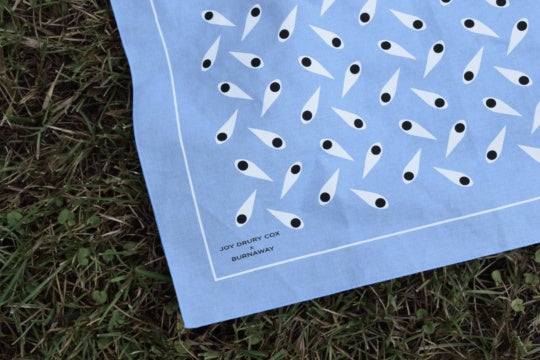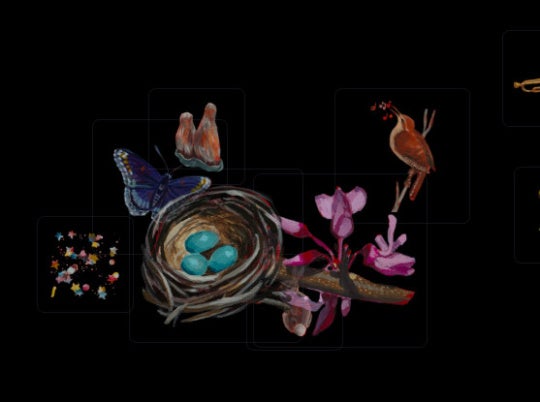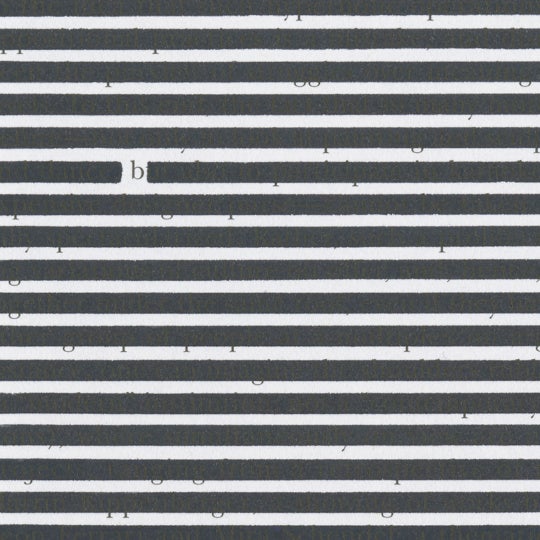
Approaching the creative practice of Atlanta artist Alessandra Hoshor is like looking into a prismatic polyhedron: the power to split light into a spectrum of constituent colors mesmerizes, yet demonstrates what light is and how it behaves. Hoshor’s multifaceted output reveals much about sensation and emotion; her works evince a sensitive understanding of perception’s mechanisms and nimbly convey emotional and narrative content through abstraction. Including videos, paintings, performances, electronic music, curation, and more, her artworks and collaborative projects entrance as they explore expectations of perception, probe associations of sensory input with emotion, and present diverse images of artful Atlanta living.
Hoshor is particularly skilled at disrupting spatial and temporal orientation. In a music video she made for the song Truth and Falling by Los Angeles electronic musician Kevin Greenspon, fluctuations between figural and nonobjective images deconstruct a fleeting moment. Opening frames enter into a single family home, and center attention on a female figure draped in a white dress, her hand and arm cradling her head while she reclines face-down on a staircase covered in a dense carpet runner. Structures and objects shift from representational content to dreamy abstraction: visual distortions push the plush carpet out of the space it normally occupies, and the staircase’s balusters illumine and contort until they bounce in and out of reality. These effects warp the point of view established in the opening frames, conflating it with that of the female figure, positioning viewers in oscillation between first- and third-person narratives.

Collaborations with well-known artists suggest how stimulation and subversion dance in Hoshor’s practice. In February, she created video projections to accompany performances by artist, musician, and nightlife persona Juliana Huxtable, among others, at a transmedia show at Mammal Gallery. Experimental rapper Abdu Ali’s March 11 I’m Alive Tour stop at the Atlanta Contemporary was presented in part by her curatorial project Nasty Cowboy. I recently sat with Hoshor to talk about these and other projects, and our conversation ventured from her creative process and the collaborative spirit of Atlanta’s arts scene to the politics of her practice and its socioeconomic context. With an air of deliberate spontaneity, Hoshor recalls the value of play: there is a part of art that is simply about making silly or impressive things for and with friends. Hoshor, to sum her many endeavors, imagines the potential of play, strangeness, and serendipity in life, in social relations, and in art.
Jared Butler: How did the show with Juliana Huxtable go? What was it like to make videos for the sets?
Alessandra Hoshor: That night was great. It went late! I actually didn’t even meet her because I was in the back doing projections, but her work is amazing – so cool.
JB: You have a studio at the Goat Farm. What are you up to there?
AH: That’s right, I share a studio with Addison Adams. I’m working on tapestries right now – silk tapestries, kind of like distressed flags. I did one recently that says “Hurt Plaza,” which is near GSU. I freehand them but super, super precisely. They’re emotional texts in a way, but only singular phrases. They’re kind of commercial feeling, but they’re also very multisymbolic. The type of thing you’d hang up and think about in multiple ways, but the core is emotional. Like, years ago I was walking in Savannah and passed a store that was closing and saw this green sign in the window that said “Everything Must Go.” I was thinking about that for a long time, and then eventually I had these green silks I was waiting to paint something on. I was like, “Oh, it needs to be like a flag – ‘Everything must go.’” It’s very meaningful to me right now – thinking about letting things go – there’s something spiritual about it, and then also you have that commercial aspect.

JB: It’s funny you say that – a meticulous kind of freehand. In your videos, your choices in manipulating forms are elegant, graceful. Fluctuating elements, transitions, are seemingly random, but they’re meticulous. There’s so much planning in every departure.
AH: I document all the time. It’s a lot of play and inside jokes and writing things down and being silly with friends. Everything I document, I bring it all in together: garbage, seemingly meaningless information or passing moments, transitional space – you know, places, photographic places that aren’t intended for use, or to be noticed. The sort of stuff I’m sincerely, immediately moved by. Portraits. And then I just slowly take out everything that doesn’t make me feel something. It’s a recreating, reconfiguring, reprocessing experience – with a creative, generative aspect. There’s projection as well as processing, if that makes sense.
JB: Absolutely. There’s this sort of refiguring, reprocessing, reforming material and, for me, an immediate connection between a selected form and an emotional response. Whether that form is in a painting, or video effect, or performance – whatever the medium or project might be –there’s an immediate connection between the forms you choose and an emotional response.
AH: Cool, definitely. If I’m not moved by something, if I don’t feel it’s sincere, then it’s not working. It all comes from heightened emotional and perceptual spaces – there’s a lot of sensitivity involved. There’s this entertaining aspect to my work – I like things to be stimulating. That can mean emotionally stimulating or visually stimulating. Or hopefully the two together.
JB: I can see that emphasis on stimulation in the work. Playing, testing, experimenting – are these words that you associate with that process?
AH: I guess it’s kind of like intentional experimentation as far as if something doesn’t work, I won’t use it. Sometimes chance plays a big role in order to find something that feels more genuine. If everything is planned and literal it doesn’t feel as real as something that’s a metaphor. The motion your brain has to make from going from, like in a music video, the visual metaphor to the text in the song, and the intended meaning between those two spaces – that’s where you have something that feels really developed and real. If it’s too literal, your brain doesn’t get to develop its own attachments. Instead of a document, you need a flexible system.

JB: In [the music video for Kevin Greenspon’s] Truth and Falling, I love the abstraction of the banisters, the particular way they move and dance with the perspective of the frame, and come to almost recall the sun’s glare on squinting eyelashes. Somehow that detail translates this entire conversation between all the aspects of that moment – shifting perspectives, paths of motion, feelings. The abstractions tell that moment’s many narratives at once because of those clear formal choices.
AH: Well, I work with isolation a lot. I mean sometimes it’s the opposite, like in Guerilla Toss there’s everything, like, burning billboard commercial, fucked-up commercial. But, before I started playing music, I would hear the song and try to feel what kind of imagery was in it – not too literally but a sensitive, kind of synesthetic way.
JB: This focus on the act of perception or of processing a stimulus is connected to the art-making process you’re describing?
AH: Yeah, I’ve started painting again, and changed the way I paint recently. After I started playing music I had this shift. I’ve had to get, in some ways, into a looser concept of painting, and in some ways, a tighter concept. The concepts are more playful and the execution is more precise, instead of being, “This is really meaningful because of these exact reasons,” and “I’m just gonna jump in and start painting without knowing what it’ll turn out like.” It’s hard to describe that headspace. But I guess I am getting into layering images and meaning in paintings the same way I’m getting into layering and meaning in music.
JB: Music seems to be key to the openness in visual work.
AH: Also getting excited about something instead of making it feel obligatory. Like, “I’m going to paint this thing and it will be so fun and I can’t wait to see how that’s going to look,” instead of going in with a really strict, “This better be meaningful.” In the end, the work feels more meaningful and more genuine to me. It feels closer to what I want to see, closer to the content I’m interested in.
JB: Is it important to find consistent meaning or unifying principles in your practice and the many forms your creative output takes?
AH: I think so. It comes from such a constant space; my brain is always going, so it takes a lot of different forms. I guess only some of it is “diligent work;” a lot of it is “these ideas keep coming and coming and coming,” and I’d finally get to the point where I’m like, “this has to happen, I’ve been thinking on this for so long, this finally has to happen.” I always have a constant – there’s a place where I’ve come to as far as the political position of my work. I question art and my involvement in it, but I also find art to be super important. And the social aspect of it is huge, too. I’m opening myself up to a lot of collaboration and public events. But the class aspect of art has always been a huge challenge for me.

JB: So would you position your way of working and those myriad forms of expression as economically determined or as simply the way it has to be to get it out there?
AH: Interesting. I think I’ve been privileged to have access to a lot of resources – my mom being a computer arts and animation professor and my dad is a software engineer, so computers have always been something in my life, in both creative and logical ways. But I think what keeps me participating are my friends. I think I need art to function, for my own well-being, and I know a lot of people that do, too, and it’s nice to support each other in it and to collaborate. People are a huge aspect of why I continue to make work.
JB: Do you see those characteristics in Atlanta’s art scene in particular? How would you characterize the local arts community?
AH: A lot of what I’ve done here is facilitate other artists. I like to make sure that other people who I think are doing really important, critical work also have an audience. I’ve been doing a basement gallery [as part of the “spatially fluid” curatorial project Nasty Cowboy] with artist and former Low Museum curator Jordan Stubbs, musician and music video artist Valentina Tapia, and Lisa McCusker, a farmer interested in rehabilitation and caretaking. There’s also a fluid, semi-anonymous curatorial staff. We emphasize queer, people of color, really incredible artists that are not getting a lot of traction yet. Artists from other cities, too. Kind of bringing out the more risqué side of Atlanta’s art scene, because there are a lot of amazing artists making work that’s genuine, intuitive, angry, weird, and challenging. People are starting to collaborate with each other, and there’s a burgeoning fashion and art scene happening, but it’s all super young. It’s in an interesting place right now. The most important thing is to harness that, push that forward, instead of aiming to just move somewhere else. I think we have enough here to work with: there are a lot of ideas, amazing people here, it’s unique, and there are special things happening here that aren’t happening in other places.
JB: What’s been most significant about Atlanta’s impact on your work?
AH: I guess the artists here. Collaborating with artists here. Meeting so many people – it’s increased my awareness of other people, which has been really important. And increased my awareness of things like structural issues in city planning, things you can’t ignore because they’re everywhere.
Guerilla Toss – 367 Equalizer (Official Video) from Alessandra Hoshor on Vimeo.
JB: You do get that sense of how everything is utterly interconnected. And for so many beliefs, behaviors, and emotions that inform or otherwise impact how policies get implemented, how things happen.
AH: Oh yeah, one little dysfunction leads to a lot of dysfunction. Everyone’s working really hard to change things, but there are so many structural, long-term issues.
JB: And so many variables need to be taken into consideration. Even with the architecture you see – like the typical mixed-use developments – they propose solutions to legitimate problems with Atlanta’s urban development and density, but aren’t they often just a parking garage surrounded by big box stores?
AH: The transportation issue is definitely central to living here. Atlanta has so many gaps – huge. It’s a fragmented, fractured city, definitely. And that’s the hard thing about art, too, it’s so often one of the first steps in gentrification. That’s the hardest part. I do like to work with existing establishments, but as far as the basement gallery, it’s not formal. That’s a big thing about it: it’s not formal, even if it is part of a larger art context. And that’s one thing I’m excited about – bringing something comfortable, informal, and aware into our scene.
JB: It’s interesting – the connections you make between experimenting with structures of perception and adopting a political mode that’s subtle, silly, critical, and intellectual.
AH: Well, I think it’s just very natural. Those decisions happen on a subliminal level – politics are always present, even if I’m being really playful and silly and open. There are such intense boundaries and sensitivities. That’s also why I like to support other artists, because I don’t think that I can say everything on my own. I’m one voice, and I try to facilitate other voices.
JB: What do you think could be the most effective role art can play in urban renewal?
AH: Something that people in the neighborhoods can access. And that’s a problem with a lot of the mixed-use developments, so many of the people already living nearby don’t necessarily have access.
JB: From the art-making process as you describe it, to how you participate in the city’s art scene and communities, there’s a kind of bricolage: wandering about, gathering material, documenting, saving it, recomposing it. And with that, specific ways of approaching time and space, not to mention social norms.
AH: Yeah, that’s what I love about Guy Debord – roaming around, détournement and dérive. And social geography and architecture – I think about that all the time.
JB: You said no matter how silly the work gets there will always be a political conversation or association. Are the criticisms we’ve mentioned of Atlanta in particular and the art market at large based in a critique of American capitalism in the early 21st century?
AH: Obviously, whatever decisions you make in your work and life, you have to be aware of the context you’re working in, and you have to be aware of other artists and their work. You have to understand you’re part of an industry. And with all of that, it can be nagging, but originality can’t be the goal, although freshness is important. It’ll be of the moment – things may seem redundant or done before but sometimes remain fundamentally valuable in a cyclical way, over a long amount of time. Meaning has such a way of recreation, regeneration, or translation across human experience. There are a lot of issues though that are particular to our time: identity issues and restructuring economy and wealth – particular things that have to be addressed.
Alessandra Hoshor is Creative Director of Nasty Cowboy, an advertising associate at ART PAPERS, and records music as Pamela_ and her sons and, in tandem with Valentina Tapia, as BIG DED. She formerly co-directed Non-Fiction Gallery in Savannah, alongside Alycia Linke and Samantha Felton.




